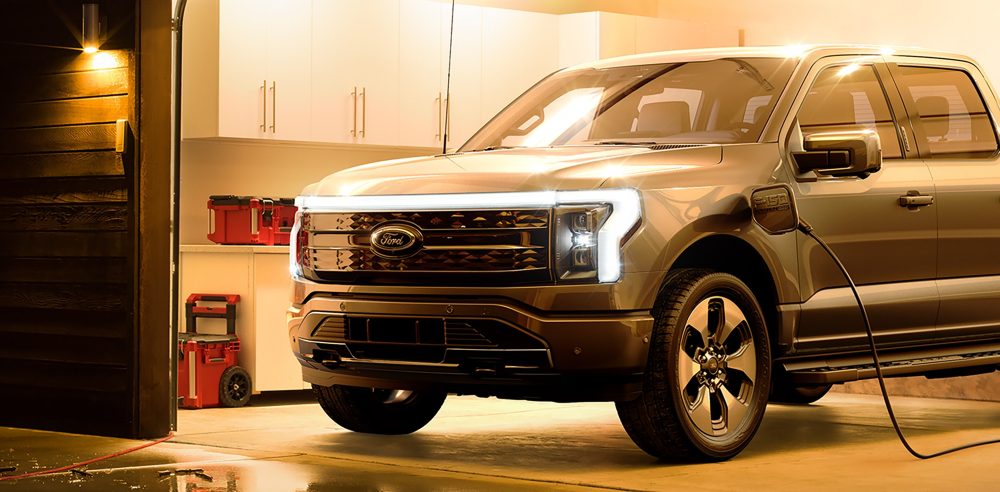Electrek sat down with Darren Palmer, head of battery-electric vehicles at Ford, to discuss the automaker’s launch of the F-150 Lightning and the company’s broader electric ambitions.
After Ford unveiled the F-150 Lightning this week, the EV community was for the most part impressed by the specs and the price point that the automaker announced.
The performance are comparable or better than Ford’s best gas-powered pickup trucks.
On the electric side, with a starting price under $40,000 for a base version with 230 miles (370 km) of range and an extended range option with 300 miles (480 km) of range, it is hard to complain.
Some will of course, but for the most part, the EV community seems to agree that Ford could sell as many F-150 Lightning pickup trucks as they can produce.
That’s why when we sat down with Darren Palmer, head of battery-electric vehicles at Ford, our first question was about bringing the electric pickup to volume production.
Palmer said that Ford is not sharing planned production capacity, but he made it clear that they are aiming for volume production of the electric truck:
“I think you can see we are not in this to build a couple of trucks and the facility that you saw President Biden visit this week, where the truck is going to be built, is significant. We also need to get the batteries to do this. We are doing that and you are going to see more about that at the capital market day next Wednesday, but again, we are not in this for a couple of trucks.”
Ford hasn’t confirmed the battery pack capacity of the truck yet, but both options are definitely over 100 kWh.
The company is well aware that if they plan to produce the F-150 Lightning in volume, it is going to need a lot of battery cells.

A supply partnership with SK Innovation was secured early on to supply the cells for the electric F-150 and Ford took it a step further this week with a joint-venture with SK to deploy another 60 GWh of battery cell production capacity in the US.
In our interview, Palmer hinted at more announcements on the battery front during an event coming on Wednesday.
You can watch our full interview with Darren Palmer on Youtube or the audio version on the Electrek Podcast (Apple Podcasts, Spotify, Overcast, Pocket Casts, Castro, and RSS):
Palmer also made a point that Ford relies heavily on customer feedback in the development of its vehicles and the F-150 Lightning is no exception.
It starts with commercial customers who require reliable vehicles at the right price point and retail consumers benefit from that while Ford also listens to them for all the features and niceties that you’d expect in a consumer vehicle.
Therefore, with the F-150 Lightning, Ford made sure that truck buyers would get all the capacity and features they are used to plus all the advantages of electric vehicles.
One of those features that Ford is betting on is Vehicle-to-Load, which enables F-150 Lightning owners to power their home, a job site, or virtually anything using the truck’s battery pack.
Palmer also explained that Ford is trying not to overwhelm buyers with electrification and it is trying to simplify the process of going electric.
For example, with the extended range version, Ford is providing an 80-amp charger that enables charging the large battery of the truck overnight.
The company is also not releasing all the nitty-gritty details of the truck’s electric powertrain, like the kWh capacity of the battery pack, which Palmer believes most people don’t really understand, but he did say that Ford will release all the details, including usable and full battery pack capacity, ahead of production next year.
We expect Ford to share more details and highlight more features of the F-150 Lightning over the next year – leading up to the start of production in mid-2022.
Subscribe to Electrek on YouTube for exclusive videos and subscribe to the podcast.

buy lasuna pill – buy lasuna tablets himcolin where to buy
cheap gabapentin – order gabapentin 600mg pill sulfasalazine 500mg canada
purchase celebrex online – buy celecoxib without prescription buy indocin 75mg for sale
buy generic benemid 500mg – purchase monograph pills buy carbamazepine 400mg
voltaren for sale online – cambia usa buy aspirin 75mg generic
oral mestinon 60 mg – buy generic pyridostigmine buy imuran pill
buy generic rumalaya – purchase shallaki for sale endep 50mg ca
baclofen 25mg brand – piroxicam 20 mg without prescription buy feldene pills for sale
buy voveran cheap – diclofenac price nimodipine pills
brand periactin 4 mg – cost zanaflex tizanidine pill
trihexyphenidyl pills – voltaren gel order online where can i buy voltaren gel
deltasone 20mg pill – order omnacortil 20mg pills permethrin online
buy accutane 20mg pill – buy generic dapsone online deltasone 5mg usa
purchase betnovate online cheap – order monobenzone buy cheap generic benoquin
purchase permethrin without prescription – acticin online tretinoin price
flagyl medication – order cenforce 100mg generic order cenforce online cheap
buy clavulanate pills – order levoxyl generic levothyroxine online order
order losartan pills – buy cozaar pills keflex 125mg cheap
buy generic cleocin for sale – buy cleocin cheap purchase indomethacin for sale
cost provigil – meloset 3 mg us meloset 3 mg us
purchase eurax online cheap – mupirocin without prescription buy aczone pills
purchase zyban – buy shuddha guggulu paypal buy shuddha guggulu no prescription
order xeloda 500mg generic – danazol generic danazol price
buy generic estrace – anastrozole 1mg cost oral anastrozole
order dostinex 0.25mg online – alesse cost buy alesse paypal
жЈи¦Џе“Ѓг‚·гѓ«гѓ‡гѓЉгѓ•г‚Јгѓ«йЊ гЃ®жЈгЃ—い処方 – г‚їгѓЂгѓ©гѓ•г‚Јгѓ«гЃ®иіје…Ґ г‚·г‚ўгѓЄг‚№ еЂ‹дєєијёе…Ґ гЃЉгЃ™гЃ™г‚Ѓ
гѓ—гѓ¬гѓ‰гѓ‹гѓі гЃ®иіје…Ґ – г‚ўг‚ュテイン通販おすすめ г‚ўг‚ュテイン еЂ¤ж®µ